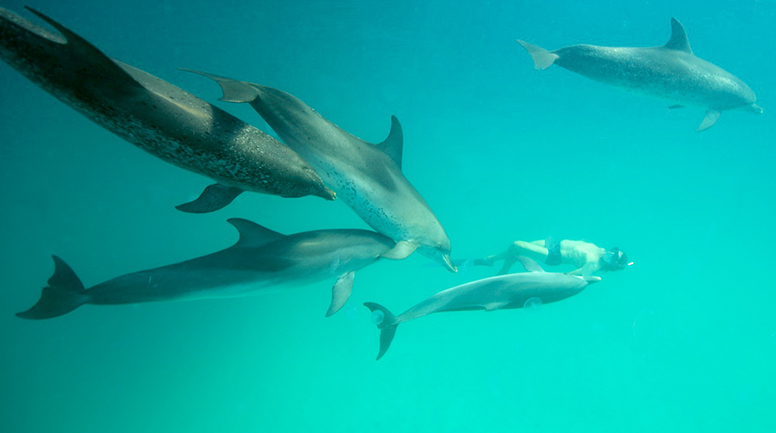
For the past four or five years, I’ve spent a few months of the year in the Bahamas, at WildQuest, swimming and diving with wild dolphins and helping others enjoy the same. It’s a wonderful experience in itself, but what has it taught me about running? What do our flippered, undersea friends know about running?
[This article first appeared in the wonderful Running Conscious blog by Julia Chi Taylor, guaranteed to inspire] Through watching and, well, hanging out with dolphins, I’ve come to see many ways that I can improve my efficiency. Most of these observations are made with pods of Atlantic Spotted dolphins and Bottlenose dolphins that reside in Bahamian waters, on what is known as the banks, a vast area of sandy bottomed water with a depth of between five and fifteen meters.
Every breath…
Like us, dolphins are air-breathing mammals. Unlike us, they spend their lives underwater, in an airless environment, and for a dolphin, every molecule of oxygen is important. Dolphins are conscious breathers, meaning that there is no autonomic nervous system to regulate their breathing. If a dolphin becomes unconscious, she drowns. A dolphin will normally dive and hunt or play for a few minutes, then come back to the surface, take a couple of breaths, then dive down again. They have some body modifications to help them with this. For example, as well as haemoglobin for transporting oxygen, they also have myoglobin, allowing them to store oxygen in their muscles. Not only are they conscious breathers, they can slow their heart rate down (from about 100 bpm to 10-20 bpm) when needed. But most importantly, they know how to make the best use of a lungful of air.
In my time swimming with them, I’ve noticed that they are very relaxed about being underwater. They will often dive as a group of two or three, quite slowly, hunt on the sandy bottom for sandfish or sand eels. Or they may play tag with each other or gently harass a nearby female (if they are males) or possibly come and interact with any nearby humans. Just for fun… Although they appear to have a rhythm of a breath every two to four minutes, they can easily stay down for much longer. And when coming back to the surface, there is no desperate rush to grab a gasp of air, but a leisurely return to the surface, or sometimes they will turn back down to investigate another fish. When a dolphin returns to the surface, they will expel the air in their lungs and breathe in a new lungful in a fraction of a second (0.3 secs according to studies). Normally repeat that two or three times before diving down.
When I compare this to how we are in the water, kicking, splashing and thrashing, I can see we waste a lot of oxygen and energy. But then we do not need to stay underwater. When I first started diving, I could stay down for thirty seconds, then my lungs and diaphragm started to heave. And yet floating on the surface, I could hold my breath for two to three minutes easily. I started to look at how I waste oxygen in the way I dive. For instance, moving the arms and hands is of little benefit when swimming underwater. Accelerating to move quickly then slowing down is a waste. Getting startled or panicked by a sudden movement or a shark will increase the heart rate and burn oxygen.
So I started to practise diving slowly with the minimum of effort, taking it easy and I soon managed to dive for up to two minutes. More than enough time to hang with some aquatic friends.

Although we normally see dolphins from the deck of a boat, possibly leaping and splashing, beneath the water it is often a different story. Moving slowly and gracefully, a flick of the tail or slight twist of the body, without any great hurry (especially true of the older ones, the youngsters, like youngsters everywhere, love to burn off energy). They are beautifully attuned to their environment and move through it with great finesse.
Just relax and run
The result of all these experiences in the water is that I started to look at how to conserve energy while running. I had long noticed that when running, if another runner (or cyclist or…) triggered some anger in me, then my heart rate increased as did my need for oxygen. Whereas relaxing and “thinking happy thoughts” would bring my heart rate down.
It’s also useful before starting a run to slow down consciously and, if you do pre-run stretches, to do them slowly. I sometimes run to my heart rate (keeping it between certain levels), so I notice even a small increase and running a kilometre at 140 is different than running a kilometre at 150. During a run, after a while, my shoulders start to tense up and that tension in my muscles consumes calories and oxygen. Being aware of my body and relaxing whatever tensions I find are a good way of conserving energy. If I can conserve one calorie a minute, over a four hour marathon, that is 240 calories, or 10% of my energy requirements. I’m not sure how many calories are burned by tense shoulders, but I suspect that it is more than that.
How are my legs moving? Do I have tension in the calves? Or the outside of my thighs? By moving more from my hips and hara region I can relax my leg muscles a bit. That swing of the hips is made much simpler by a straight back and good posture (I also tend to hunch over when tired, a great waste of energy). Running with a straight back and relaxed body not only feels great, but conserves energy and means that we can run further before exhaustion kicks in. Saving a calorie a minute may not sound much, but when you add it up over a whole long run, then it starts to make a difference. A marathon distance can burn 2,500 calories and at 2,000 calories I tend to hit the wall, so even reducing this by 200-300 calories helps a lot. Although I don’t think there is any need to emulate the dolphin’s almost instant expulsion and inhalation of air, I have started to look at the effect our breathing has on our oxygen needs. There is currently a theory that when we breathe through our nose, our bodies enter a more relaxed state and when we breathe through our mouths then our bodies take that as a sign of needing to burn faster. And as a diver, when preparing to dive, it’s better to inhale sharply and release the air slowly.
Unfortunately I find it quite difficult to control my breathing as it tends to follow the running automatically. But is is an area I’m interested in experimenting with and trying to be more conscious of. So, relax the body, breathe consciously, take it easy and enjoy! By saving a little effort here and making a deeper breath there, it slowly adds up to a less strenuous run and that, of course, makes it more fun.